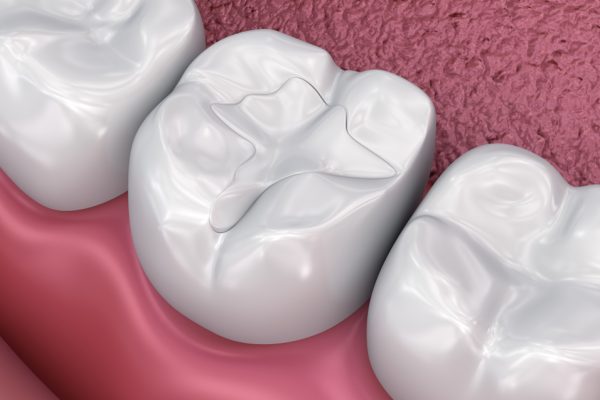Everything You Need to Know About Dental Fillings
Have you ever experienced that sharp, shooting pain when biting into ice cream or sipping a hot cup of coffee? Tooth sensitivity, decay, and cavities are common problems that can cause discomfort and impact your overall oral health. It’s estimated that 1 in 4 adults have untreated tooth decay, and approximately 9 in 10 adults have had a cavity. Dental fillings offer a solution to restore the integrity of your teeth and prevent further damage.
Our Fort Wayne dentist covers everything you need to know about dental fillings, from understanding their purpose to choosing the right material and navigating the costs involved.
What Are Dental Fillings?
Dental fillings are a means of restoring a tooth damaged by decay to its original function and form.
Fillings can be made from a variety of materials, including:
- Composite resin
- Amalgam
- Porcelain
- Gold
Why Are Dental Fillings Necessary?
Dental fillings are necessary to restore teeth that have been affected by decay, cracking, breaking, or wearing down, restoring them to their normal function and form. Fillings are crucial in preventing damage, as untreated tooth decay can lead to further complications, such as infection and tooth loss.

What Are Cavities?
Cavities, also known as dental caries, are caused by bacteria forming acid on the tooth’s surface due to frequent consumption of sugar and starches.
When we consume food and beverages, especially those high in sugar and carbohydrates, bacteria in our mouth produce acids that can attack the tooth’s enamel — the hard, protective outer layer of the tooth. Over time, these acid attacks can cause tiny openings or holes to form in the enamel, leading to the formation of cavities.
If left untreated, cavities can progress and affect the deeper layers of the tooth, such as the dentin and pulp, which can cause pain, sensitivity, and infection. Symptoms of cavities may include toothache, sensitivity to hot or cold temperatures, pain while chewing, and visible holes or dark spots on the teeth.

Dental Filling Materials
Silver Amalgam Fillings
Silver amalgam fillings, sometimes referred to as “silver fillings,” are a mixture of metals, including mercury, which is utilized to fill cavities caused by tooth decay. Dental amalgam is a metal alloy composed of mercury, silver, tin, copper, and zinc in varying proportions. The advantages of amalgam fillings include their durability, cost-effectiveness, and simple application.
However, the drawbacks of amalgam fillings include their visual impact, susceptibility to corrosion, and potential for mercury toxicity. Despite these concerns, the American Dental Association (ADA) has stated that amalgam fillings are safe and effective for treating cavities.
Composite Fillings (Tooth-Colored Fillings)
Composite fillings, or tooth-colored fillings, are composed of a mixture of ceramic and plastic. They’re utilized to restore a tooth that has been damaged by decay, cracks, fractures, and other issues. Tooth-colored plastic composite is the most widely employed filling material.
Composite fillings are known to be robust, long-lasting, and can be tailored to match the hue of your teeth. Additionally, the bonding to the tooth helps to deter further decay.
However, composite fillings are more expensive than other types of fillings and may not have the same longevity. Additionally, they take more time to place than other types of fillings.
Other Filling Material
Dental fillings can also be composed of gold, porcelain, composite resin, and ceramic. Gold fillings are known for their strength and longevity, but they can be expensive and difficult to color-match with the rest of your teeth. Porcelain fillings boast strength and longevity, but they’re costly and may be challenging to blend in with the color of your teeth.
Composite resin fillings possess great strength and longevity, but they can be more costly than other filling options. Ceramic fillings are known for their strength and longevity, though they may be pricier than other filling types.

The Dental Filling Process
The dental filling process involves a series of steps, starting with the dentist determining if a patient needs a filling by examining the teeth using a small mirror and specialized instruments, as well as taking X-rays if necessary.
If a dentist determines that a dental filling is necessary, they’ll remove the tooth decay and sanitize the affected area before filling it with the appropriate material.
Preparing the Tooth
Before placing a filling, a local anesthetic is used to numb the area around the tooth. Then, the dentist uses a drill, air abrasion tool, or laser to remove the decayed area of the tooth.
The cavity is then thoroughly cleansed of bacteria and any residual debris to ensure all tooth decay is eliminated before placing the filling.
Placing the Filling
Following the removal of the decay and cleaning of the area, the tooth-colored material is applied in successive layers, hardened with a specialized light, and formed to the desired outcome by the dentist. Any excess material is then trimmed away, and the restoration is polished to ensure there are no sharp edges around the filling and to prevent any potential friction between the filling and the surrounding tissue.
The process of filling a cavity is a relatively simple one, but it’s important to ensure that it’s done correctly to ensure the best possible outcome. The dentist must take into account the size and shape of the cavity, the type of material used, and the patient’s individual needs.
Post-Procedure Care
After receiving a dental filling, it’s advisable to abstain from eating hard, chewy, or sticky foods for up to two weeks, as well as avoid hot and cold beverages for a few days. Rinsing three times daily with warm salt water can help alleviate pain and swelling following a filling.
Brushing your teeth after a dental filling shouldn’t be postponed, as maintaining good oral hygiene is essential for preventing further tooth decay.

Cost and Insurance Coverage for Dental Fillings
The cost of dental fillings can be influenced by several factors, such as the material used, the position of the tooth in the mouth, the size of the cavity, and the oral health status.
The typical cost range for a dental filling is generally between $100 and $150.
Factors Affecting the Cost of Fillings
The cost of dental fillings is influenced by the type of filling material employed, such as composite resin or silver fillings, the position of the tooth in the mouth, the degree of damage, and the number of teeth being filled. Porcelain fillings are generally the most costly option for mending a cavity or damaged tooth.
The positioning of the tooth in the oral cavity and the magnitude of the damage and the quantity of teeth being filled can also influence the expense of the filling.
Dental Insurance and Fillings
The coverage of dental fillings under dental insurance plans may differ, depending on the plan. Once you have met your deductible, dental insurance plans usually will cover the services associated with dental fillings. This typically includes costs for materials, labor, and anesthesia.
The coverage for dental fillings will vary depending on the plan.

Potential Issues and Solutions With Dental Fillings
Potential issues that may arise from dental fillings include inadequate cavity preparation, contamination of the preparation before the restoration is placed, or fracturing of the restoration due to biting or chewing trauma.
It’s not uncommon for tooth sensitivity to occur after a filling, which may be due to pressure, air, sweet foods, temperature, or an allergic reaction to the materials used in the filling.
Sensitivity and Pain After a Filling
Tooth sensitivity following the placement of a filling is a common occurrence, and your tooth may be sensitive to pressure, air, sweet foods, or temperature. Generally, the sensitivity will dissipate within a few weeks, but if it persists, your dentist may suggest a desensitizing toothpaste or a fluoride gel as potential solutions.
If the sensitivity is caused by an allergic reaction, your dentist may recommend an alternative type of filling material.
Filling Replacement and Maintenance
The durability of the filling material and the possibility of recurrent decay are potential issues associated with the replacement and maintenance of dental fillings. Normal wear and tear from chewing, grinding, or clenching can cause dental fillings to wear away, chip, or crack.
Visiting the dentist every six months is essential for monitoring the health and functionality of the fillings, ensuring they are not deteriorating from normal wear and tear such as chipping, cracking, or wearing away.
Tips for Preventing Cavities
Proper oral hygiene practices and dietary habits can help prevent cavities and protect teeth from further damage. By adhering to these practices, you can maintain optimal oral health and minimize the need for dental fillings.
Proper Brushing and Flossing Techniques
It’s recommended to brush your teeth with fluoride toothpaste and to clean between teeth daily with floss or an interdental cleaner. The recommended brushing technique involves placing the toothbrush at a 45-degree angle where the gums and teeth meet, using small circular motions to gently brush the gumline and teeth, and brushing every surface of every tooth, including the cheek-side, tongue-side, and chewing surfaces.
For flossing, cut a piece of floss approximately 18 inches long and tie the ends around each hand’s middle finger until the hands are about 3 inches apart.
Diet and Lifestyle Factors
Consuming a balanced diet that includes whole grains, fruits, vegetables, and lean sources of protein, while limiting sugary and acidic foods and beverages, can help promote dental health.

Frequently Asked Questions
Generally, fillings can last anywhere between five and 30 years depending on the type of filling materials, size, and location of the tooth. With proper care, maintenance, and regular checkups, fillings usually last around 10 to 15 years before needing to be replaced.
Most people find that the discomfort associated with receiving a filling is mild to moderate, and shouldn’t be too uncomfortable. Your dentist will provide you with a local anesthetic to ensure that the targeted area is numb.
However, everyone experiences pain differently and some patients may feel more discomfort than others.
The five different types of fillings include:
- Amalgam fillings
- Composite fillings
- Ceramic fillings
- Glass ionomer fillings
- Gold fillings
With advances in dental technology, these options offer safe, durable, and aesthetically pleasing solutions to restoring damaged teeth.
It’s recommended that you wait at least two hours to eat after having a newly filled tooth. Even then, make sure to avoid very hard or sticky foods to prevent damaging your new filling.
Repair Tooth Decay With Dental Fillings at Union Chapel Dentistry
Understanding the different types of dental fillings, the filling process, and the costs involved can help you make informed decisions about your dental care. By practicing proper oral hygiene and maintaining a balanced diet, you can reduce the risk of tooth decay and the need for dental fillings. Remember to visit your dentist regularly for checkups and cleanings to ensure the longevity of your dental fillings and overall oral health.
Schedule your appointment with our Fort Wayne dentist today.
